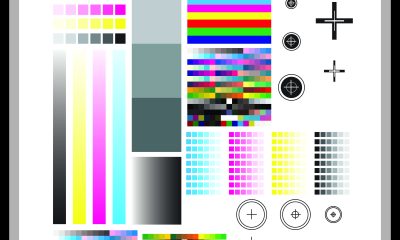My editor told me this issue’s theme was going to be inkjet, but quickly added I could write about another topic. Somehow, he got the idea I was not enamored with inkjet printing. I wonder why? (Editor’s note: Because I’ve read your columns before.)
My editor told me this issue’s theme was going to be inkjet, but quickly added I could write about another topic. Somehow, he got the idea I was not enamored with inkjet printing. I wonder why? (Editor’s note: Because I’ve read your columns before.)
Here’s the thing: I’m old enough to have come up through shops where they cut stencils by hand. I’ve operated large litho cameras and midsize stat cameras to size art and make film positives. I used hot wax, and not to remove body hair. I’ve printed short-run 4 x 8-ft process-color jobs and made enough one-off display and exhibition prints to equip a medium-sized museum—all on screen presses.
So I appreciate the inkjet printer and all it does for today’s screen shops. Thinking back on all those old-school “silk-screening” applications, I honestly have to say that in the 19 years since I first saw wide-format digital printers (an SGIA show in St. Louis, if my dim lacquer-soaked brain is still functioning), I seem to have developed, if not a flat-out heart-pounding love for these ink-spitting monsters, at least a friends-with-benefits relationship. I still get a thrill from the squeegee and the screen, but the fact of the matter is that inkjet is pretty good looking. Weirder still—and this may explain the growing attraction—the older inkjet gets, the better it looks and the cheaper it gets (at least on the initial date).
One thing I have noticed: Inkjet printers don’t care who you used to go out with (screen printers, offset printers, quick printers, photographers, sign shops, etc.). They’ll share your affections and your jobs. They’re always eager to please and don’t mind taking over chores that you used to do with your old production equipment (which, let’s be frank, wasn’t showing you much love anyway). Like an old flame from high school, things changed and you moved on.
Film production is probably the one area where inkjet gets unconditional love from this old ruby-cutting fool. I recently inspected some inkjet film positives side by side with imagesetter output, and the detail achieved from the inkjet was better. But that’s just superficial beauty. The real deal for me is how, with an assortment of inexpensive films, anyone with a desktop printer can output professional quality positives, which is helping to fuel the explosion of DIY screen printing going on now. All the rock poster people, T-shirt start-ups, art printers, and mom-and-pop shops can do their films in house, chemical free, and at a low cost.
The bigger screen shops on the display side are the ones that have become infatuated with inkjet, in some cases divorcing screen printing completely. Many others see the benefits of keeping both technologies around, since one complements the other. Is this “process polygamy?” Maybe. Should we care? No. Screen printers were never part of the normal print society anyway. We’ve always been the weirdoes of the imaging world. Where “normal” printers concern themselves with paper, we create t-shirts and touch screens, glass panels and goalie sticks, solar cells and stop signs. We make our own rules.
Advertisement
As long as we’re playing true confession, let’s look at some downsides of the inkjet revolution. For me, there are three main ones:
Live fast, die young: I have a nice two-pole screen-printing press that’s at least 15 years old. A bit of grease and $20 worth of new air hoses and it’s good for another 15 years of production. Hands up: Anyone out there running a 10-year-old inkjet printer? OK, how about five years old? Yeah…I thought so. Nowhere in the printing trade has the concept of planned (or unplanned) obsolescence been more apparent than in inkjet printing. Bring money. Print fast. Buy a new one.
Pixelation across the nation: Kids today are unaware of the beauty and boldness of spot color, and the current crop of graduating graphic designers appears to have lost touch with the concept of designing for the medium. There seems to be very little knowledge of the various printing processes and their strengths, weaknesses, and requirements. Inkjet can’t do everything and never will, contrary to what that slick salesperson at the SGIA show told you. The history of print is one of change, adaption, application, and invention.
Hot, but high maintenance: Like Johnny Depps’ wife in the movie Blow, the initial attraction eventually wears off and then reality sets in. Inkjet printers need TLC too. Unlike screen presses, they require specific, sometimes proprietary inks and specialized materials for individual machines. Mess with anything outside those guidelines and you may pay a price, usually in the form of a technician you bring into your shop at your expense to tell you the printer needs new heads because of an unauthorized ink you used.
Still, inkjet has managed to thaw even this old squeegee-holic’s heart. If you’re still on the hate/hate side of the fence, you may want to reconsider. Succeeding in this business today means constantly evaluating not only what you want, but what your customers desire. True love only occurs when everyone in the relationship is happy.
Advertisement

 Art, Ad, or Alchemy1 month ago
Art, Ad, or Alchemy1 month ago
 Case Studies1 month ago
Case Studies1 month ago
 Andy MacDougall1 month ago
Andy MacDougall1 month ago
 Columns2 weeks ago
Columns2 weeks ago
 Editor's Note2 weeks ago
Editor's Note2 weeks ago
 Thomas Trimingham2 months ago
Thomas Trimingham2 months ago
 Marshall Atkinson2 weeks ago
Marshall Atkinson2 weeks ago
 News & Trends1 month ago
News & Trends1 month ago















